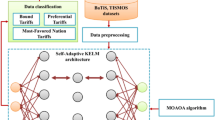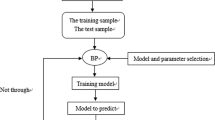Abstract
Due to the complexity of economic system and the interactive effects between all kinds of economic variables and foreign trade, it is not easy to predict foreign trade volume. However, the difficulty in predicting foreign trade volume is usually attributed to the limitation of many conventional forecasting models. To improve the prediction performance, the study proposes a novel kernel-based ensemble learning approach hybridizing econometric models and artificial intelligence (AI) models to predict China’s foreign trade volume. In the proposed approach, an important econometric model, the co-integration-based error correction vector auto-regression (EC-VAR) model is first used to capture the impacts of all kinds of economic variables on Chinese foreign trade from a multivariate linear analysis perspective. Then an artificial neural network (ANN) based EC-VAR model is used to capture the nonlinear effects of economic variables on foreign trade from the nonlinear viewpoint. Subsequently, for incorporating the effects of irregular events on foreign trade, the text mining and expert’s judgmental adjustments are also integrated into the nonlinear ANN-based EC-VAR model. Finally, all kinds of economic variables, the outputs of linear and nonlinear EC-VAR models and judgmental adjustment model are used as input variables of a typical kernel-based support vector regression (SVR) for ensemble prediction purpose. For illustration, the proposed kernel-based ensemble learning methodology hybridizing econometric techniques and AI methods is applied to China’s foreign trade volume prediction problem. Experimental results reveal that the hybrid econometric-AI ensemble learning approach can significantly improve the prediction performance over other linear and nonlinear models listed in this study.
Similar content being viewed by others
References
L. Yu, S. Y. Wang, and K. K. Lai, A hybrid econometric-AI ensemble learning model for Chinese foreign trade prediction, in Proceedings of the 2007 International Conference on Computational Science (ICCS 2007), Part IV, LNCS 4490, Beijing, 2007, 106–113.
National Bureau of Statistics of China. URL: http://www.stats.gov.cn/.
China’s Future, Fortune, September 29, 1999.
Ministry of Commerce of China. URL: http://www.mofcom.gov.cn/.
World Trade Organization, International Trade Statistics, November 9, 2006.
J. M. Bates and C. W. J. Granger, The combination of forecasts, Operations Research Quarterly, 1969, 20: 451–468.
S. Makridakis, A. Anderson, R. Carbone, R. Fildes, M. Hibdon, R. Lewandowski, J. Newton, E. Parzen, and R. Winkler, The accuracy of extrapolation (time series) methods: results of a forecasting competition, Journal of Forecasting, 1982, 1: 111–153.
E. Pelikan, C. de Groot, and D. Wurtz, Power consumption in West-Bohemia: improved forecasts with decorrelating connectionist networks, Neural Network World, 1992, 2: 701–712.
I. Ginzburg and D. Horn, Combined neural networks for time series analysis, in Advances in Neural Information Processing Systems (ed. by J. D. Cowan, G. Tesauro, and J. Alspector), Morgan Kaufmann, San Mateo, CA, 1994, 224–231.
R. Clemen, Combining forecasts: a review and annotated bibliography with discussion, International Journal of Forecasting, 1989, 5(4): 559–608.
L. Yu, S. Y. Wang, and K. K. Lai, A novel nonlinear ensemble forecasting model incorporating GLAR and ANN for foreign exchange rates, Computers & Operations Research, 2005, 32(10): 2523–2541.
J. A. Benediktsson, J. R. Sveinsson, O. K. Ersoy, and P. H. Swain, Parallel consensual neural networks, IEEE Transactions on Neural Networks, 1997, 8(1): 54–64.
M. P. Perrone and L. N. Cooper, When networks disagree: ensemble methods for hybrid neural networks, in Neural Networks for Speech and Image Processing (ed. by R. J. Mammone), Chapman-Hall, 1993, 126–142.
L. Breiman, Arcing classifier, The Annals of Statistics, 1998, 26(3): 801–849.
R. F. Engle and C. W. J. Granger, Co-integration and error-correction: representation, estimation, and testing, Econometrica, 1987, 55(2): 251–276.
S. Ghosh and D. Lien, Forecasting with preliminary data: a comparison of two methods, Applied Economics, 2001, 33(6): 721–726.
D. F. Hendry and N. R. Ericsson, An econometric analysis of U. K. money demand in monetary trends in the United States and the United Kingdom by Milton Friedman and Anna J. Schwartz, American Economic Review, 1991, 81(1): 8–38.
K. Hornik, M. Stinchocombe, and H. White, Multilayer feedforward networks are universal approximators, Neural Networks, 1989, 2(5): 359–366.
H. White, Connectionist nonparametric regression: multilayer feedforward networks can learn arbitrary mappings, Neural Networks, 1990, 3(5): 535–549.
L. Yu, S. Y. Wang, and K. K. Lai, A rough-set-refined text mining approach for crude oil market tendency forecasting, International Journal of Knowledge and Systems Sciences, 2005, 2(1): 33–46.
D. Sullivan, Document Warehousing and Text Mining: Techniques for Improving Business Operations, Marketing, and Sales, Wiley, New York, 2001.
A. Krogh and J. Vedelsby, Neural network ensembles, cross validation, and active learning, in Advances in Neural Information Processing Systems (ed. by G. Tesauro, D. Touretzky, and D. Leen), MIT Press, Massachusetts, 1995, 231–238.
N. Ueda, Optimal linear combination of neural networks for improving classification performance, IEEE Transactions on Pattern Analysis and Machine Intelligence, 2000, 22(2): 207–215.
B. H. Kang, Unstable weights in the combination of forecasts, Management Science, 1986, 32(6): 683–695.
V. Vapnik, The Nature of Statistical Learning Theory, Springer-Verlag, New York, 1995.
S. Y. Wang, L. Yu, and K. K. Lai, Crude oil price forecasting with TEI@I methodology, Journal of Systems Science and Complexity, 2005, 18(2): 145–166.
L. Yu, S. Y. Wang, and K. K. Lai, Foreign-Exchange-Rate Forecasting with Artificial Neural Networks, Springer, New York, 2007.
L. Yu, S. Y. Wang, and K. K. Lai, Credit risk assessment with a multistage neural network ensemble learning approach, Expert Systems with Applications, 2008, 34(2): 1434–1444.
Author information
Authors and Affiliations
Corresponding author
Additional information
This research is supported by the National Natural Science Foundation of China under Grant Nos. 70601029 and 70221001, the Knowledge Innovation Program of the Chinese Academy of Sciences under Grant Nos. 3547600, 3046540, and 3047540, and the Strategy Research Grant of City University of Hong Kong under Grant No. 7001806.
Rights and permissions
About this article
Cite this article
Yu, L., Wang, S. & Lai, K.K. Forecasting China’s Foreign Trade Volume with a Kernel-Based Hybrid Econometric-Ai Ensemble Learning Approach. J. Syst. Sci. Complex. 21, 1–19 (2008). https://doi.org/10.1007/s11424-008-9062-5
Received:
Revised:
Issue Date:
DOI: https://doi.org/10.1007/s11424-008-9062-5




